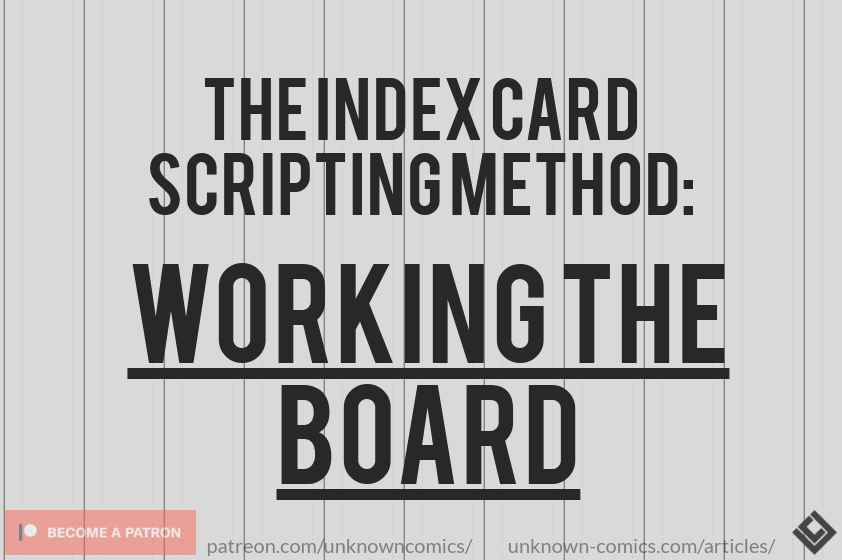Now we’ve reached the final part of our 3-part series on the Index Card Scripting Method: Working The Board.
(Sources Notice: Please keep in mind that Unknown Comics will at times use third party source material. Be sure to check the bottom of the article for the Sources button.)
This article will bring together what was discussed when we were learning about the board and the cards. We will get a chance to see what you should start doing with this tool, what you can do to add depth, and finally, edit it so that you can get in front of your keyboard (or typewriter… I don’t judge) and get to writing a kick-ass comic script!
An important note to make before reading this article; I will not be diving too deeply into the significance of some of the terms I’ll be mentioning today. I strongly recommend getting yourself a copy of Blake Snyder’s Save The Cat! The Last Book on Screenwriting You’ll Ever Need. It’ll help fill in some of the technical gaps I’ll be discussing below. This article will be focusing on the broad strokes and I’ll be sharing some personal thoughts and suggestions.
Before We Begin: You’ll Only Need 40
Like I mentioned in the first article in this series, the board is a great way to spend a lot of time thinking about a story and really polish it up.
But here is the idea, the goal is to come up with a well-defined story.
You will put up as many cards on this board as you may want. Just remember this one thing. You will only end up with 40 cards in total. Cards stacked on each other count as a single one.
Be sure to set a deadline for yourself. Once you reached a certain point, you will have to start to either push back your deadline, drop the script, or start removing cards from your board to get down to 40.
The Cards You’ll Need To Add First
Where It Burns…
Well, if you’re thinking of writing a comic then you probably have some pretty amazing scenes just wreaking havoc in your mind just itching to get out. These are the first cards you’ll fill out. These may even be the very cards you’ll be stacking for details. Don’t be afraid to pin these on your board where you’ve sort of been thinking they would be best placed in.
In case you’ve forgotten, you set up your board to have the look of The 3 Act Structure.
Quick Reminder: Don’t Get Discouraged
Remember, now is definitely not the time to be getting demoralized by the vast blank spaces between cards. This is why we’re making sure we’re working the board and making sure we have a complete story before getting down to writing.
Now we get to the major turns.
Major Turns
Blake Snyder makes a good point in his book. After pinning up the scenes that drove you to devote all this time to working the board you now need to make sure you have your major scene turns clearly pointed out.
These major turns include:
- Opening Scene
- The Midpoint
- Act One Break
- Act Two Break
- All Is Lost
Determining these points in your story early on in your process of working the board will act as a guide, telling you where your story will have to end up eventually.
What You’ll Notice While Working The Board
Too Many Cards, Not Enough Scenes
Now, as we discussed in the previous article, each card represents a scene in your story. Do not make the mistake of putting up cards next to each other when they aren’t a scene on their own.
Don’t make a single chase scene take up 7 cards next to each other.
Don’t forget that for cases like these you should be taking advantage of stacking your cards. When you do this you’re adding depth to a scene, not making a new one.
Identify The Black Holes
After you’ve added those awesome, thought-provoking scenes and laying out your major turns you’ll probably get started and go crazy. You’ll be adding scenes all over the place.
But eventually, you’ll start to realize that you have quite a few gaps in between scenes. These are your black holes. These are blank spots between your scenes where you’re missing story; a tieing plot to connect one point of your story to the next one further down. For example, you don’t know how to tie that chase scene with your morning routine montage.
Don’t worry, this is what the board is good for. Telling us where we’ve been missing a good chunk of the plot. Take your time and work your way through it.
Like the article so far? Support the production of more articles like this one!
The Empty 3rd Act
One other common problem with the board is that it’ll make it pretty evident that you probably don’t know how to end your story.
The third act, according to Blake Snyder, is quite often the emptiest of the rows in your board.
It’ll haunt you…
Just make sure that all your underlying stories along with your main storyline get resolved in this act.
Working Your Board To Polish Your Story
Color Coding Begins!
Even I think this tool greatly benefits from some added color!
With the board, you can color code just about any specific detail you’d like.
Some suggestions of what you can color code are:
- “Story points that follow and enhance theme and repeating imagery.”
- “Minor character arcs can be traced…”
- A, B, “C, D, and E stories can” get a specific color assigned to them.
- Depending on the type of comic series you’re writing you can even color code cross-story arc plots.
Strip It Down
As previously mentioned in this series. Each scene must exist in order to drive the story forward.
So you’ve finally gotten to the point where you feel enough story is on your board.
Now you have to make sure you bring the number of cards down to 40.
It’s pretty likely you’ll have more than 40 cards on your board. If ever, now is the time to get down to working this board. If you had 70, 65, 50, even 43. You’ll have to bring it down to 40.
Why do we do this?
Well, it’s to make sure that:
- You didn’t accidentally make something a scene that shouldn’t have been (maybe something you could have stacked or simplified into one card).
- You don’t have unnecessary scenes.
- Your acts don’t last forever!
You may end up with a blank space. Don’t worry, you can give yourself a little slack for once you get down to the actual script writing!
Let’s not forget the +/-
If you’re going to work the board you really can’t ignore the emotional flow of your story.
Now I know I mentioned that your cards have to have some sort of emotional significance to the characters involved. The scene can fluctuate from +/- to -/+.
You have the option to organize your story in any particular way you like. Some people believe you must organize your story to flow in an up-down format like +/-, -/+, +/-, etc. Some people believe that it’s ok if things don’t work out this way.
Oh and if you want some help with thinning out your board; if you can’t figure out the emotional change in your scene, throw it out!
Working a Board For A Comic
Depending on the type of comic series your working with, One Shot, Limited, or Ongoing. I have been thinking of using this tool a little differently for each of these cases.
If you’re writing a one shot comic, then you’re be using this tool just as anyone writing a single movie script would. With one board.
Working Multiple Boards
If you’re working on a limited series I would recommend working as many boards as you are planning on releasing issues. Having them side by side (if possible) and tying your story together. This will help keep your story consistent and each issue feeling like it’s telling enough of a story.
Alternatively, if you’re working on a really long limited series (with multiple story arcs) or an ongoing series I would recommend working as many boards as you’re planning on releasing issues in a single story arc. While also keeping in mind what you’re planning on doing for future story arcs.
I’ve been thinking that maybe this would help long-term planning of deeper storylines.
Conclusion
A lot was unpacked in this article, but I hope it has helped you get some good ideas on how to use this tool for writing your own comic script.
You’ve learned that you’re going to end up with a functioning amount of cards. You’ve identified at least which cards you should start with to help guide your story.
You’ve learned what the board can help identify in your story… primarily all the missing pieces. This will help you better process a good plot and will call upon quite a bit of your creative prowess.
You’ve also learned what you are probably going to have to do to get to working your board so that it can be of some use to you as you plan on getting in front of your keyboard and get started in your awesome comic script.
Finally, we considered how you can use this particular tool in relation to the different type of comic series you can write. How working multiple boards together can help organize the overall story you’re planning on telling on a vast number of comic issues.
Alright now, happy scripting!
Sources
“Building The Perfect Beast.” Save The Cat! The Last Book On Screenwriting That You'll Ever Need, by Blake Snyder, Michael Wiese Productions, 2005, pp. 103-111.
Sign Up For
The Unknown Times!
Content Updates
Website News
Recommended Reading
And More to Come!
*Once every two weeks!*
Liked the article? Become part of my Patreon Community!
About The Author

Phillip Allen
Writer, Editor, and Founder of Unknown Comics
Hello there! My name is Phillip Allen and I'm the writer, editor, and founder of Unknown Comics. I am an aspiring comic book creator. In an attempt to learn how to create my own comic I came to learn just how few reliable resources existed out there. From a few books and unhelpful websites I decided to focus my attention on researching and writing a resource for both myself and the rest of the comic creating industry. This website and and its content is the result of all of that hard work.

